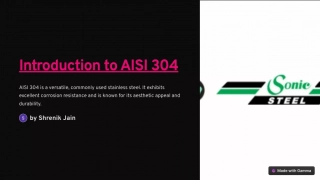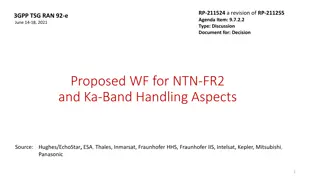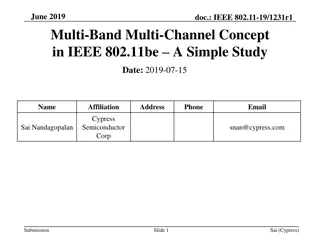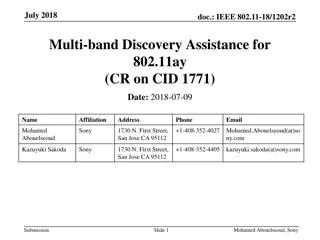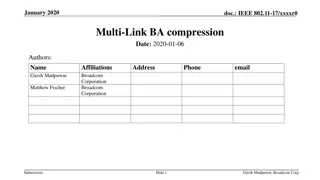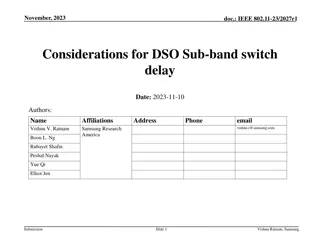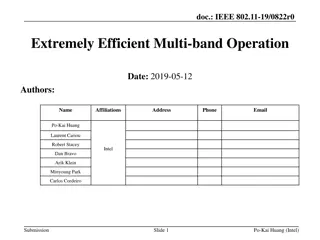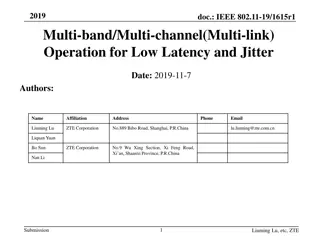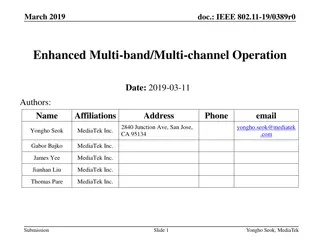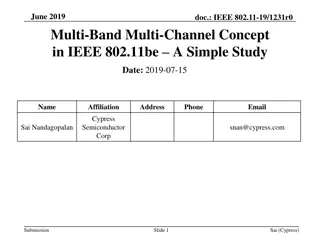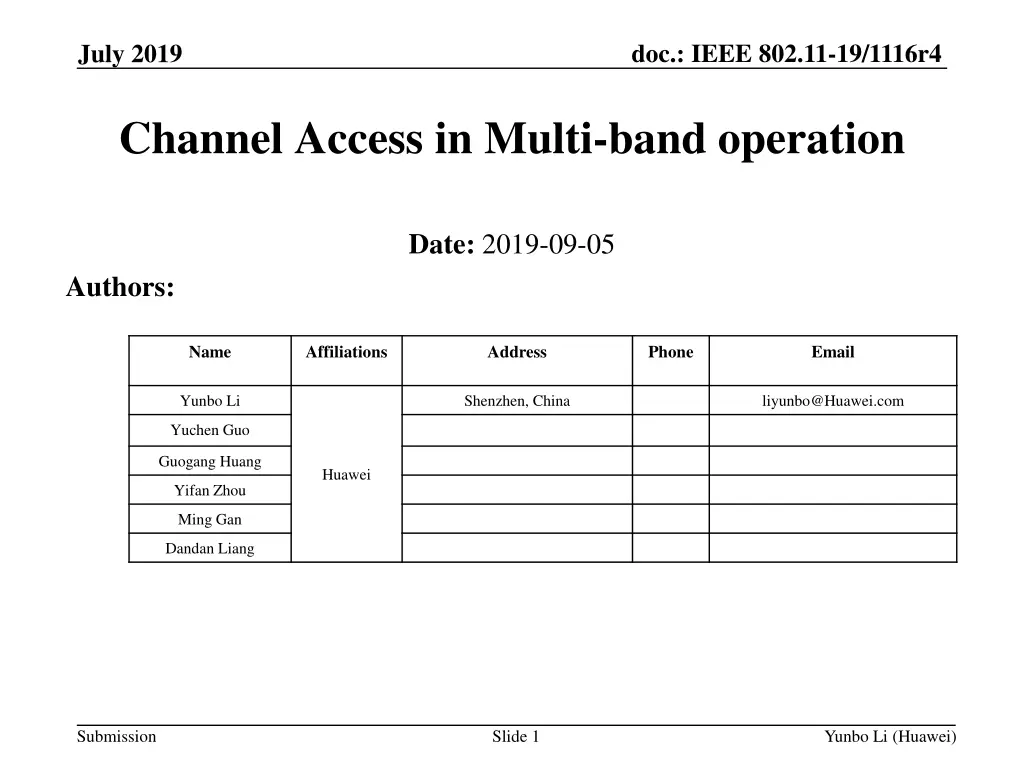
Channel Access in Multi-band Operation
Explore the concepts of multi-band/multi-channel operation in IEEE 802.11-19/1116r4, discussing the need for synchronized/asynchronized multi-link configurations, PPDU parameters, and channel access considerations for enhanced performance in wireless communication systems.
Download Presentation

Please find below an Image/Link to download the presentation.
The content on the website is provided AS IS for your information and personal use only. It may not be sold, licensed, or shared on other websites without obtaining consent from the author. If you encounter any issues during the download, it is possible that the publisher has removed the file from their server.
You are allowed to download the files provided on this website for personal or commercial use, subject to the condition that they are used lawfully. All files are the property of their respective owners.
The content on the website is provided AS IS for your information and personal use only. It may not be sold, licensed, or shared on other websites without obtaining consent from the author.
E N D
Presentation Transcript
doc.: IEEE 802.11-19/1116r4 July 2019 Channel Access in Multi-band operation Date: 2019-09-05 Authors: Name Affiliations Address Phone Email Yunbo Li Shenzhen, China liyunbo@Huawei.com Yuchen Guo Guogang Huang Huawei Yifan Zhou Ming Gan Dandan Liang Submission Slide 1 Yunbo Li (Huawei)
doc.: IEEE 802.11-19/1116r4 July 2019 Introduction Multi-band/multi-channel operation is defined in EHT PAR [1] to Increase throughput Enhance reliability Reduce latency Since the terminology Link is preferred based on discussion in [2,3], it is used throughout this contribution; Current channel access is designed for single link, how to access in multi-link need to be discussed, especially when the links are dependent. Submission Slide 2 Yunbo Li (Huawei)
doc.: IEEE 802.11-19/1116r4 July 2019 Synchronized/Asynchronized ML Based on the simultaneous TX&RX capability, there are two types of multi-link (ML); Asynchronized ML Synchronized ML Both of them are needed depending on scenarios. Asynchronized ML: The two links are far enough to ignore the power leakage from each other link. The channel access of multi links could be independent, which makes the protocol design simple. Synchronized ML: When multiple links are close to each other, the power leakage from the other link cannot be ignored, so multi-link TX/RX always need to be aligned when designing the protocol. The benefit is it can aggregate several close links to get high peak throughput, which is very important for the areas with less unlicensed spectrum. Slide 3 Submission Yunbo Li (Huawei)
doc.: IEEE 802.11-19/1116r4 July 2019 PPDU Parameters in ML PPDU length in each link is dependent in synchronized ML, which is used to align the start or end time in different links; Other parameters besides the PPDU length in each link could be independent, e.g. BW, MCS, NSTS, Dynamic bandwidth negotiation could be supported in each link independently, based on the channel status on its own channel; Similar as single link, the bandwidth of a PPDU within a TXOP should always be smaller or equal to the bandwidth of previous PPDU in the same TXOP. Submission Slide 4 Yunbo Li (Huawei)
doc.: IEEE 802.11-19/1116r4 July 2019 Asynchronized ML Each link could has its own EDCA parameters, e.g. CW_min, CW_max, AIFS, ; Channel access is independent in each link; Pros: Minor or no change is needed for channel access in standard Cons: Need large guard bands between each links, or need self interference cancellation between multi-links; Submission Slide 5 Yunbo Li (Huawei)
doc.: IEEE 802.11-19/1116r4 July 2019 Synchronized ML Always need to consider the constraint that one ML entity cannot simultaneously support TX and RX in different links during the communication; The channel access is dependent for multi-links; May have many different ways to do channel access, here we classify them into two kinds of architectures in following slides; Pros: Could support more links in the limited spectrum, or reduce the complexity of self interference between adjacent links. Cons: Complex channel access rules and transmission procedures Submission Slide 6 Yunbo Li (Huawei)
doc.: IEEE 802.11-19/1116r4 July 2019 Synchronized ML Architecture 1: there is one primary link and one or more secondary link, backoff performs on primary link; when the backoff counter is reduced to 0, the ML entity could send PPDUs on the primary link and the secondary links which the CCA results are idle in PIFS time preceding the transmission; for each transmission, the primary link should always be included; Single link STAs and legacy STAs associate on the primary link. Submission Slide 7 Yunbo Li (Huawei)
doc.: IEEE 802.11-19/1116r4 July 2019 Synchronized ML Architecture 2: There is no primary link, backoff performs simultaneously on multiple links; Two potential issues need to considered Issue 1: backoff in multiple links is usually finished at different times, but the transmission in ML need to be synchronized When the backoff in one link first is reduced to 0, and aggregate other secondary links, it will cause fairness issue in secondary links. When the backoffs in all links are reduced to 0, and then transmit PPDUs, EHT STA will have less chance to access the channel than the legacy STA; Issue 2: how to support legacy STAs and single link EHT STAs? Legacy STAs and single link EHT STAs cannot respect the constraint that ML AP entity cannot TX & RX simultaneously at different links. Submission Slide 8 Yunbo Li (Huawei)
doc.: IEEE 802.11-19/1116r4 July 2019 Transmissions in synchronized ML Two UL PPDUs, or two DL PPDUs are supported in synchronized ML; Two PPDUs can be sent by single ML entity, or different ML entities The start time of two PPDUs may not be aligned The end time of two PPDUs should be aligned One UL PPDU and one DL PPDU in different links is not supported if they have any overlapping in time domain; DL PPDU 2X Case 3 UL PPDU 1 DL PPDU 1 UL PPDU 1 UL PPDU 2 DL PPDU 2 Case 1 Case 2 Submission Slide 9 Yunbo Li (Huawei)
doc.: IEEE 802.11-19/1116r4 July 2019 Conclusion There are two types of multi-links based on the capability of simultaneous TX&RX on different links, namely, asynchronized ML and synchronized ML; Both types have their own use scenarios and benefits; The issues that need to be considered in the channel access of both types of ML are summarized. Submission Slide 10 Yunbo Li (Huawei)
doc.: IEEE 802.11-19/1116r4 July 2019 Straw Poll 1 Do you agree the PPDU bandwidths on multiple links between two multi-link devices below rules? The PPDU bandwidth on each link could be different; The PPDU bandwidth on each link is independent of the CCA of other link(s); The PPDU bandwidth selection rules in each link are the same as in single link. SP deferred Submission Slide 11 Yunbo Li (Huawei)
doc.: IEEE 802.11-19/1116r4 July 2019 Straw Poll 2 Do you agree that the channel access mechanism in each link of multiple asynchronous links can be independent from the channel access mechanism of the other links? Y:20 N:4 A:20 Submission Slide 12 Yunbo Li (Huawei)
doc.: IEEE 802.11-19/1116r4 July 2019 Straw Poll 3-a Do you agree that synchronous multiple links need a different channel access mechanism from asynchronous multiple links? Exact designs are TBD SP deferred Submission Slide 13 Yunbo Li (Huawei)
doc.: IEEE 802.11-19/1116r4 July 2019 Straw Poll 3-b Do you agree that a multi-link capable device that doesn t support simultaneous transmit and receive needs a different channel access mechanism from a multi-link capable device that support simultaneous transmit and receive on different links? Exact designs are TBD SP deferred Submission Slide 14 Yunbo Li (Huawei)
doc.: IEEE 802.11-19/1116r4 July 2019 Straw Poll 4-a Do you agree that below rule is needed on two synchronous links? two UL PPDUs, or two DL PPDUs could be transmitted concurrently, and the end times of the two PPDUs shall be aligned if responses are needed for frames carried in both PPDUs; Submission Slide 15 Yunbo Li (Huawei)
doc.: IEEE 802.11-19/1116r4 July 2019 Straw Poll 4-b Do you agree that below rule is needed for a multi-link capable device that doesn t support simultaneous transmit and receive on different links? two UL PPDUs, or two DL PPDUs could be transmitted concurrently, and the end times of the two PPDUs shall be aligned if responses are needed for frames carried in both PPDUs; Submission Slide 16 Yunbo Li (Huawei)
doc.: IEEE 802.11-19/1116r4 July 2019 Reference [1] EHT PAR document, 11-19-0244-00-0eht-eht-par-document [2] 11-19-0823-00-00be-multi-link-aggregation [3] 11-19-0822-00-00be-extremely-efficient-multi-band-operation Submission Slide 17 Yunbo Li (Huawei)

